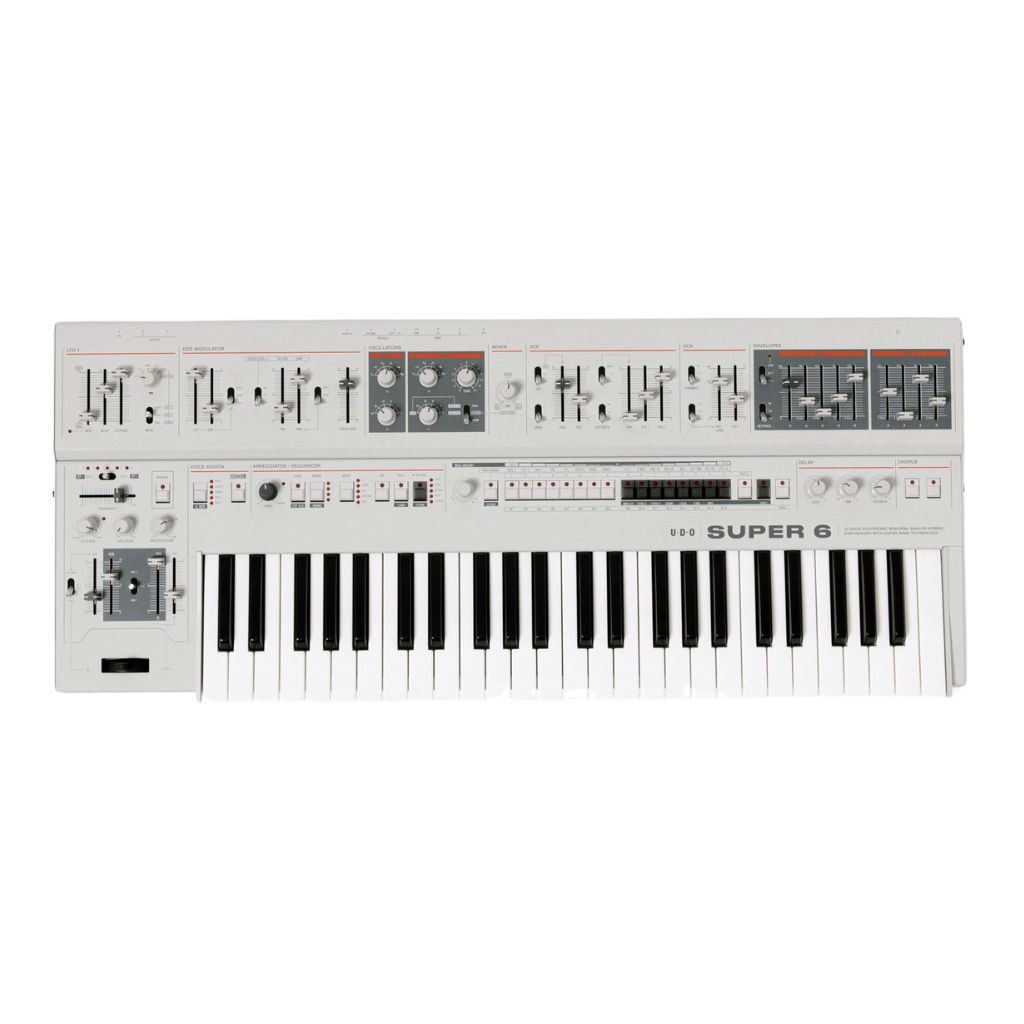The Big Review: UDO Super 6
Every superhero has an origin story. With its inaugural instrument, Bristol-based UDO plans to bring high-flying powerful polysynth action to studios around the globe.
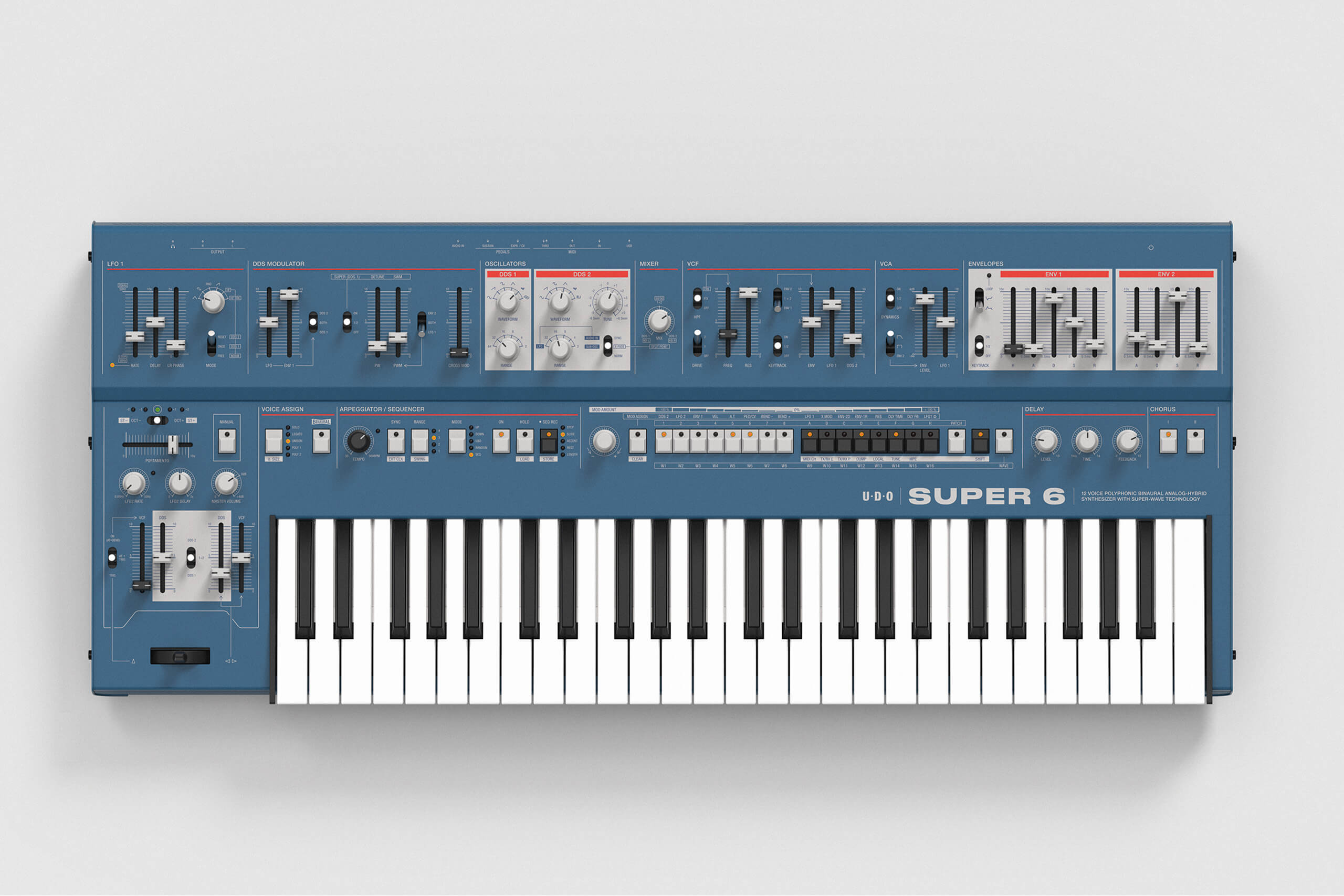

Price £2,200
Contact UDO
Those who experienced the modular mayhem of 2019’s Superbooth in Berlin will remember the strong sense that there was something new, something exciting emerging. Among the plethora of well-crafted Eurorack designs, there were a number of thrilling polysynths on display, including one from newly minted Bristol company UDO: the Super 6. The prototype presentation whet appetites for what was to come.
Even the fact that the machine was merely a silent case at the time did nothing to dampen the enthusiasm of onlookers. A year later, in the cold, harsh light of 2020 – a year whose Superbooth had to happen virtually due to a viral pandemic – we can confirm that the buzz about UDO’s stand was entirely justified. The Super 6 is here. Can it save us?
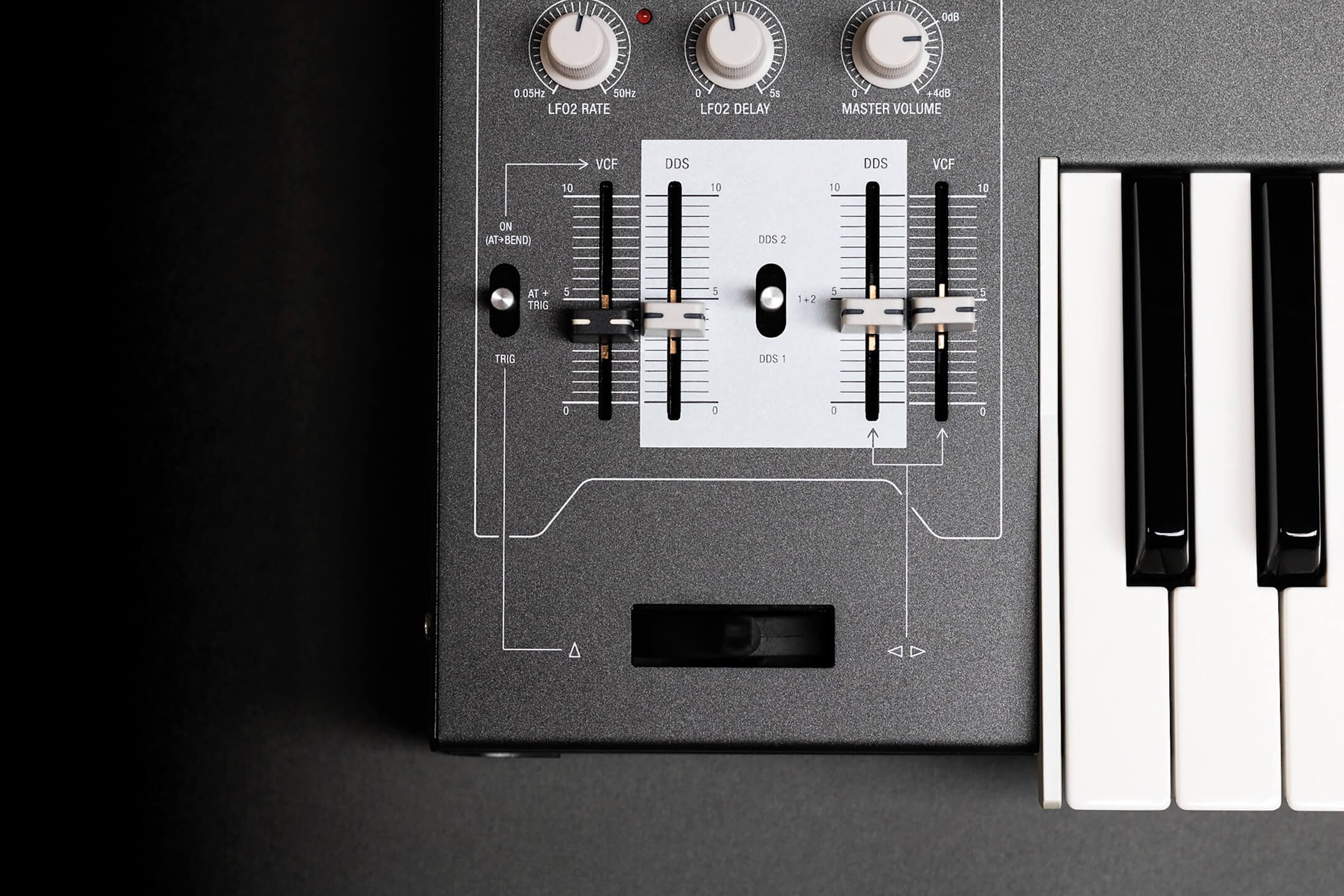
Super synth
The Super 6 is an elegant and reassuringly heavy 12-note polyphonic synth. Its all-metal chassis and 49 keys feel robust and comforting, and its bevelled corners remind us of the Arp Odyssey. UDO clearly hasn’t skimped on the quality of the pots and faders, all of which offer a dampened feel with each nudge and turn. That is, aside from the single infinite-rotation pot to the left of the patch-recall buttons.
As a performance synth, the Super 6 feels like it’s made for keyboard players and synthesists. It has a four-octave keyboard courtesy of Italian company Fatar, which feels responsive and durable in the way that all good synth keyboards do. It’s always nice to have a fifth octave but we don’t miss it while working with the Super 6.
On the far left, there’s a single pitch-and-mod lever, which gives the Super 6 a look not entirely dissimilar to that of Roland’s Juno-106 and Jupiter-6. Regardless of the synth’s likeness to industry classics, we’re quite taken by what we see. There’s something unusual about the Super 6 though, something missing. Where’s the central display?
UDO designer George Hearn wanted to create a synth that he personally would want to play, and that meant no distractions from LCD and gorgeous OLED screens. The logical way around this lack of central navigation matrix was to make the majority of Super 6’s faders, buttons and pots single purpose, with only a few parameter settings altered via additional button presses. Single-purpose buttons are something of a rarity these days, typically found only on the analogue beasts of yesteryear. Even most modern-day recreations of old analogue synths simplify their navigation via a bright screen and some cannily assigned functions. But don’t let the Super 6’s lack of display and old-school buttons fool you. This is by no means the product of a bygone age.
At its heart, UDO’s Super 6 is a musical instrument that invites play and encourages users to create as they do. It’s like an analogue classic reinvented for contemporary needs, with a smart less-is-more ethos that makes it hugely engaging.
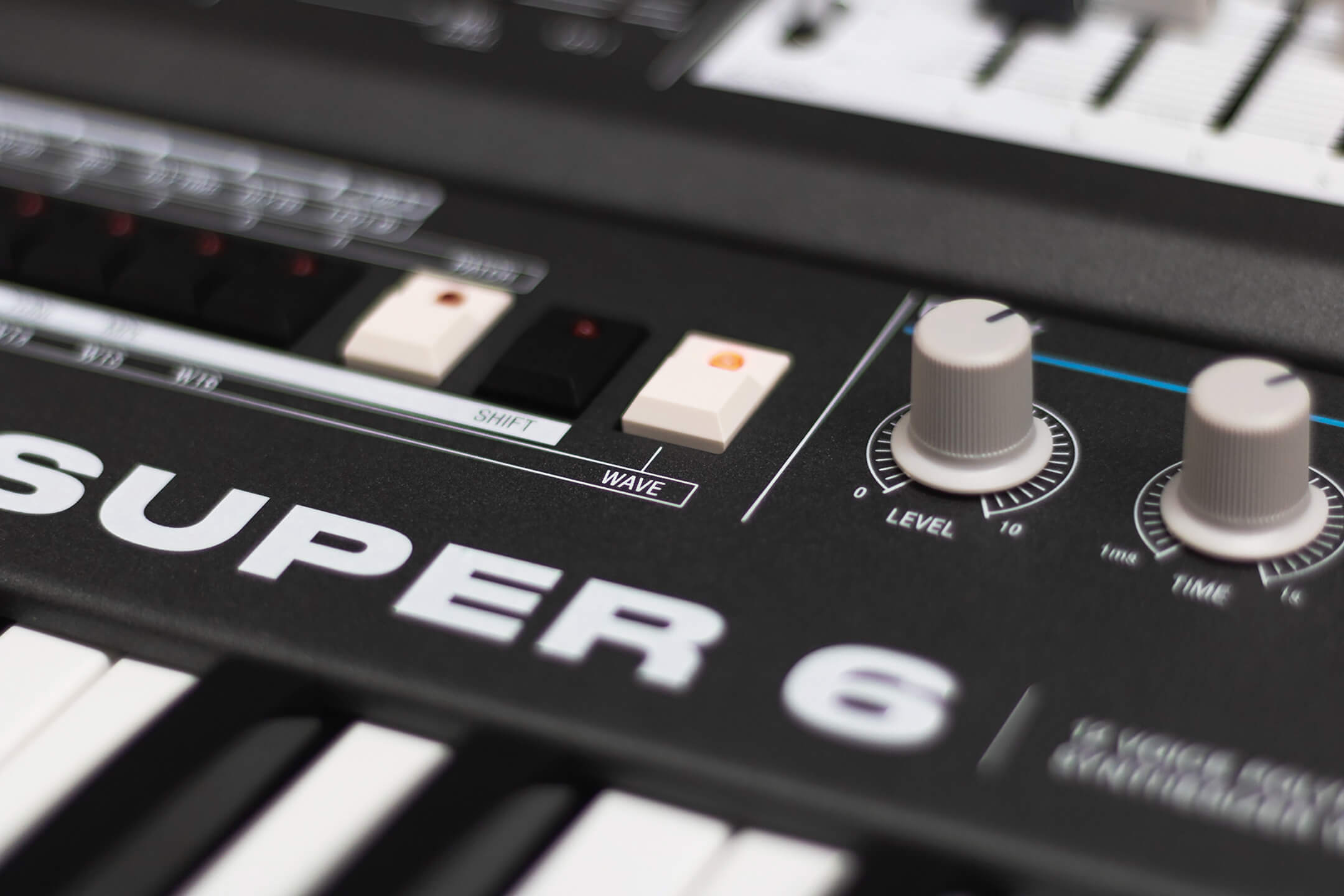
Binaural beast
Given that the Super 6 is billed as a 12-note polyphonic synth, you might be wondering why it isn’t called the Super 12. The reason for its name comes down to UDO’s choice of voice assignment. In its primary setting, the Super 6 behaves like any other 12-note polysynth, offering two oscillators per voice for a rich playing experience. The draw of the Super 6 is that, where many polysynths might use a mono oscillator at the beginning of the signal path with back- end chorus to thicken the sound, the Super 6 employs a binaural mode. Switching to this setting lowers the voice count to six notes but applies a unique texture-thickening effect at the start of the signal path. In essence, what you have here are stereo oscillators that can be modulated and detuned while allowing for some unusual and exceptional spatial effects.
This is made possible thanks to the field-programmable gate-array (FPGA) technology that sits at the core of UDO’s new Direct Digital Synthesis (DDS) oscillators. With two oscillators available, DDS 1 produces classic subtractive starting points that include sine, saw, square, triangle and noise, while accommodating up to 16 contemporary and digital waves. There’s also the option to load further waves via a computer, which means the Super 6 can sport a potent sonic palette at its front end. UDO has plans to supply additional waves via its website too.
Once connected to your computer or laptop via USB, the Super 6 appears on your desktop just like a regular USB drive. From here, it’s simply a case of dragging and dropping waves into the Waveforms folder so that they’re ready to be loaded into DDS 1.
DDS 1 has multiple functions. It can be operated conventionally but, with the flick of the Super switch, it will detune the seven kernels associated with the central pitch to create a super-wave. There are two Super modes. If the switch is in the on position, all the kernels will deliver the same amplitude. If the switch is in the in-between 1/2 position, with the central pitch at the forefront of the timbre, the kernels will be reduced. As well as giving users the ability to recreate classic Euro sounds like those associated with super-saws, the 1/2 mode arguably offers a more musical and creative playing option, as it keeps the main fundamental at the front of the sound. The Super switch is flanked by an accompanying Detune fader that dictates the amount of thickening applied too.
The Binaural button takes this party trick to the next level by getting the waves dancing around the stereo image in a way that’s quite different from the familiar chorus effect. Whichever setting you apply, the Super 6 sounds classy and enormous.
Next to the Super controls, you’ll find LFO 1. Their close proximity is no coincidence, as the pair share several associated routable options, including pitch and wave modulation. The latter, identified as SWM (super-wave modulator), can create intensity in the wave via LFO and envelope-derived modulation.
If you’re working in the stereo sweet spot, you’ll hear the full binaural experience here, as the detuning meanders and realigns again. It’s a cool effect – and it comes directly from the source, before we’ve even considered applying effects to the back end of the signal.
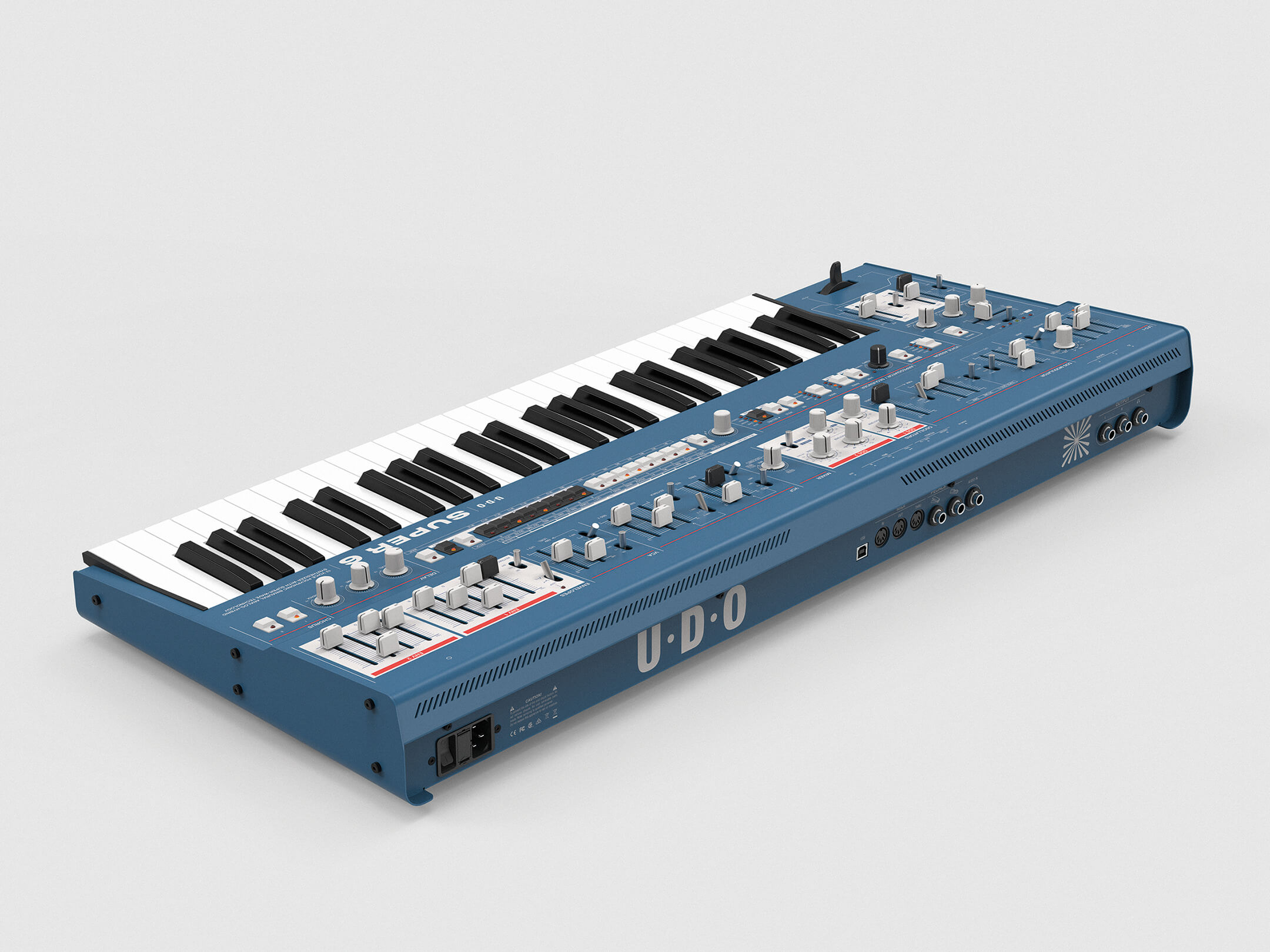
Talking ’bout my oscillation
You may expect DDS 2 to mirror the functionality and tonal sources of DDS 1. But that would be too simple and, as you’re probably realising, the Super 6 is no ordinary synth. While DDS 1 employs sampling technology for its source waves, DDS 2 employs an algorithmic core, which makes the waveforms subtly different. This does mean that you’re restricted to the more usual set of subtractive waveforms for DDS 2, which isn’t a surprise, but it offers additional functionality to make up for that.
While the five-octave range can be set from 32 to two, it’s also equipped with a sub-oscillator mode, which emits a square wave fixed one octave below the pitch of DDS 1. The mixer control allows you to blend of DDS 1 and 2, ensuring that the sub-oscillator doesn’t overpower the colours from DDS 1. This arrangement works beautifully in practice. With DDS 1’s detuning in full flight, the sub-oscillator component offers the overall texture a solid foundation. It can be overbearing when playing chords but, using the mixer, it’s easy to dial back the sub and find a suitable balance.
DDS 2 also has an input for an external audio signal, leaving it open to all the blending and modulation found elsewhere on the Super 6. More DDS-specific applications can be exploited using cross modulation. You can have DDS 2 modulate DDS 1 using exponential frequency modulation. As the fader rises, you’ll be treated to deep and familiar FM-style sounds that can range from bells to thunder claps.
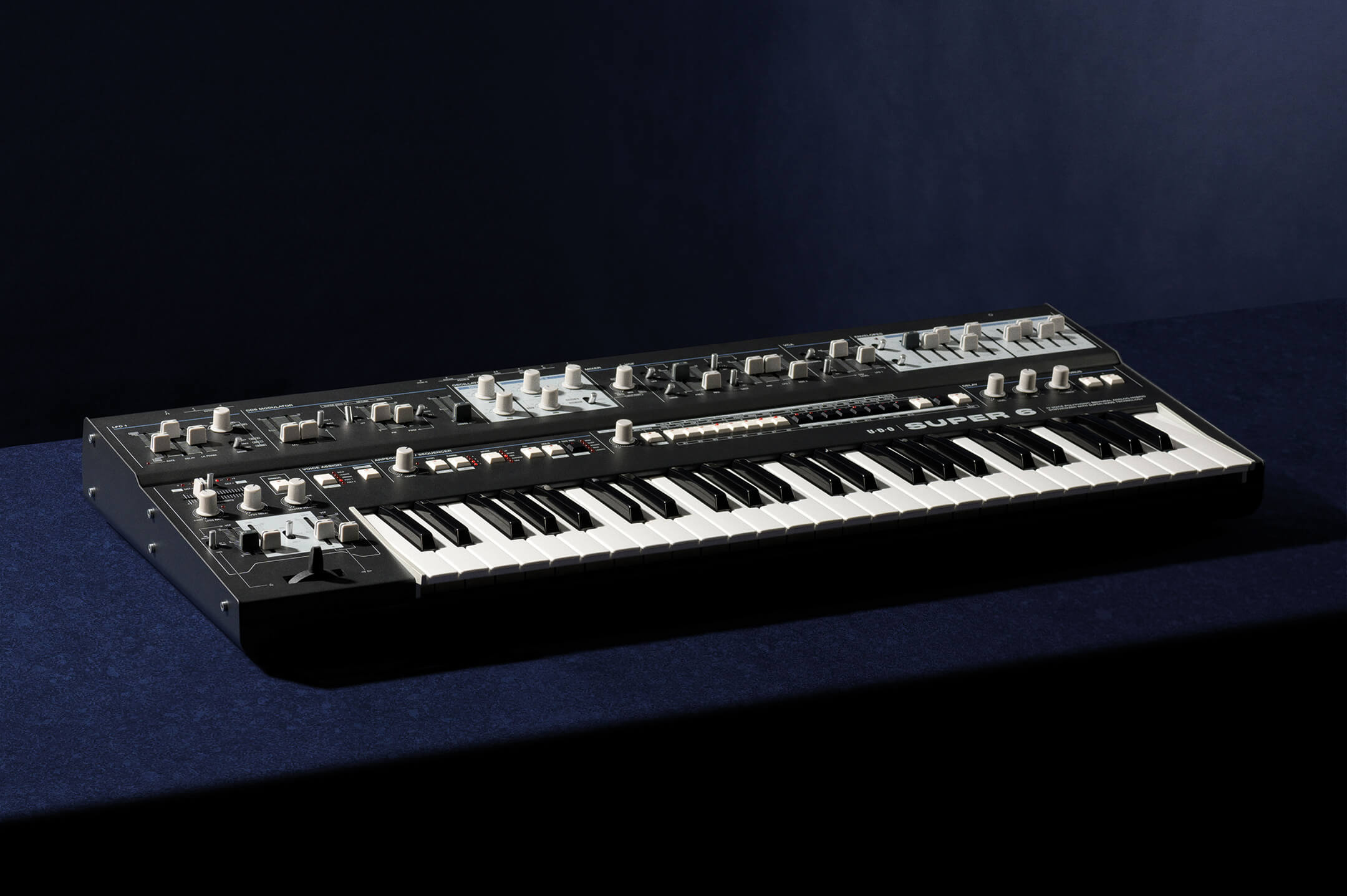
Fabulous filter
The mixed DDS oscillators feed the 4-pole 24dB low-pass filter, so there’s plenty of further functionality here. Being 4-pole, the filter – which is based on an analogue design from Sound Semiconductor – is well suited to polyphonic duties. With no resonance applied, it sounds weighty with a crisp top end that’s revealed once fully open. There’s a slight loss of low-end depth once the resonance is increased but, with two overdrive options right next door to the cutoff fader, it’s easy to replenish some of these frequencies and produce those classic squeals even if resonance is maxed out.
The behaviour of the resonance in Binaural mode is particularly interesting. With Binaural disabled, in what we could regard as mono mode, the filter sounds fantastic but is fairly predictable. Activate Binaural mode, however, and the general thickening is also applied to the resonance, making for a fascinating texture. But the filter is capable of far more than these mere basics.
Before the low-pass circuit, you can introduce a high-pass filter fixed at about 500Hhz or interlinked with the low-pass circuit. This creates a pseudo band-pass effect determined by the cutoff control.
The filter features many modulatory functions, applied via dedicated faders linked to envelope and LFO modulation. Even more influential is the DDS 2 modulation fader. While DDS 2 also has the capacity to operate in LFO mode, it’s the audio rate signals that allow for filter-based frequency modulation that creates the most extraordinary sounds. Some of those sound as you’d expect but, as is the case elsewhere with this synth, it’s the way you’re able to apply things on the fly that we find really inspiring. Combining the numerous elemental possibilities of the DDS section and then modulating these further with the filter leads to some enormous and monstrous colours. Some of these are pleasant, some aren’t. But they’re all fabulous.
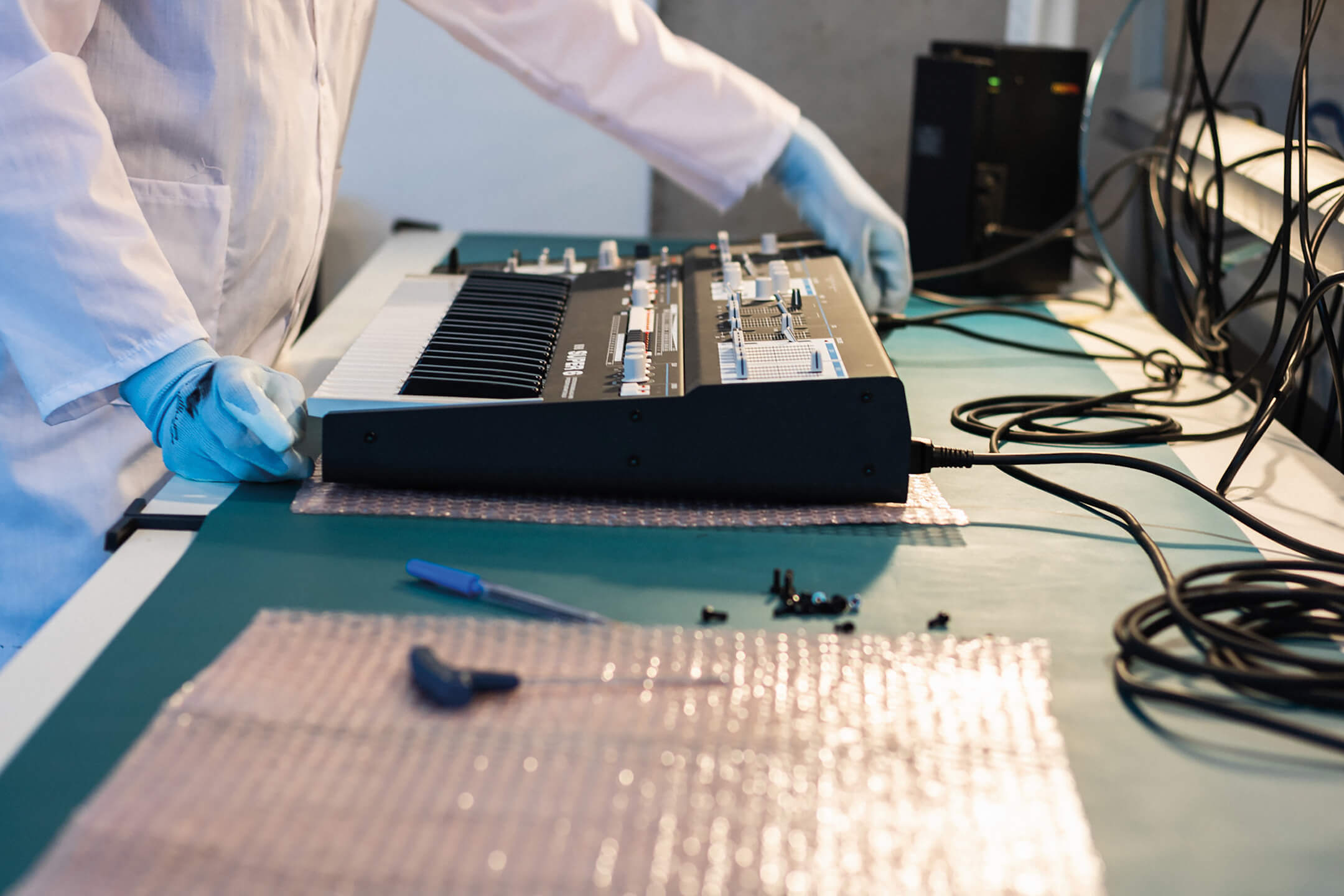
Super fly
With such a vast amount of content, it would be easy to overlook the more perfunctory functionalities of the Super 6. But that would be a mistake. Even the two onboard envelopes here are capable of some neat tricks.
Both adhere to the ADSR format but envelope 1 also boasts a hold function. Each envelope phase operates between 0-10 seconds (except sustain) with the hold element essentially delaying its travel until the specified time has elapsed. Envelope 1 also offers a nod to Serge-like designs with a looping function that allows it to operate much like an LFO, only with you controlling the rise and fall times. Tempting as that is, the Super 6 is also equipped with two dedicated LFOs. LFO 1 offers the largest choice of waveforms, from triangle to random, while LFO 2 is designed to operate specifically alongside the pitch-and-mod lever, and can modulate either pitch or filter cutoff. If two LFOs aren’t enough, you could always use envelope 1 in Loop mode or redeploy DDS 2 as an LFO.
Many synths’ modulatory attributes are hardwired, requiring the flick of a switch or rise of a fader to employ. But the Super 6 also offers a modulation matrix, which is where we expect the lack of central display to be an issue. However, thanks to the presence of bank and patch buttons, you can handle any modulation comfortably using the corresponding legends above each button. After getting to grips with the Super 6, soon you won’t even need to refer to them. There’s a choice of eight sources, which can be routed to an additional eight destinations, so you might, for example, choose to send either velocity or aftertouch to the extremities of cross modulation.
The Super 6 also boasts an onboard arpeggiator and sequencer. The former offers all the usual up, down and random configurations, up to four octaves in range. The sequencer allows for easy programming of 64-step patterns, which can also be saved in 64 locations using the central patch buttons. Sequencer patterns can also be off-loaded to a computer via USB.
As if the Super 6 required any further sound enhancement or thickeners, two chorus effects are available at the back end too, along with a fine tape-style delay that lets you control its level, time and feedback. Add to this the portamento control in the performance section and the various voice modes, which allow unison stacking, solo and polyphonic operation, and you have quite the performance and studio-bound powerhouse in the Super 6.
The final output
The Super 6 is an expert player’s synthesiser replete with functions that let you get lost in its sounds. It’s suitably different from many other synths on the market and comes with a price tag that, given the amount this synth is capable of and its extraordinary build quality, we think is very fair.
UDO still has some improvements to make to the synth’s software. It’s not currently possible to initiate Binaural mode while you’re playing, for example, yet the detuning mode engages subtly and musically as you play. But we’re confident such updates are coming.
The Super 6 has much to offer old-school synth enthusiasts, while its complex DDS oscillators go further than many synths of its kind, making it ideal for modern synth fans too. We’ve only just scratched the surface of what this super-synth can do. It’s well set up to become a future classic, then. There’s a sense that this synth has picked up the baton from those units that inspired it and is flying into the future with style. We’re intrigued to see where UDO goes next but its opening gambit certainly is super. Can the Super 6 save us? Maybe.
Do I really need this?
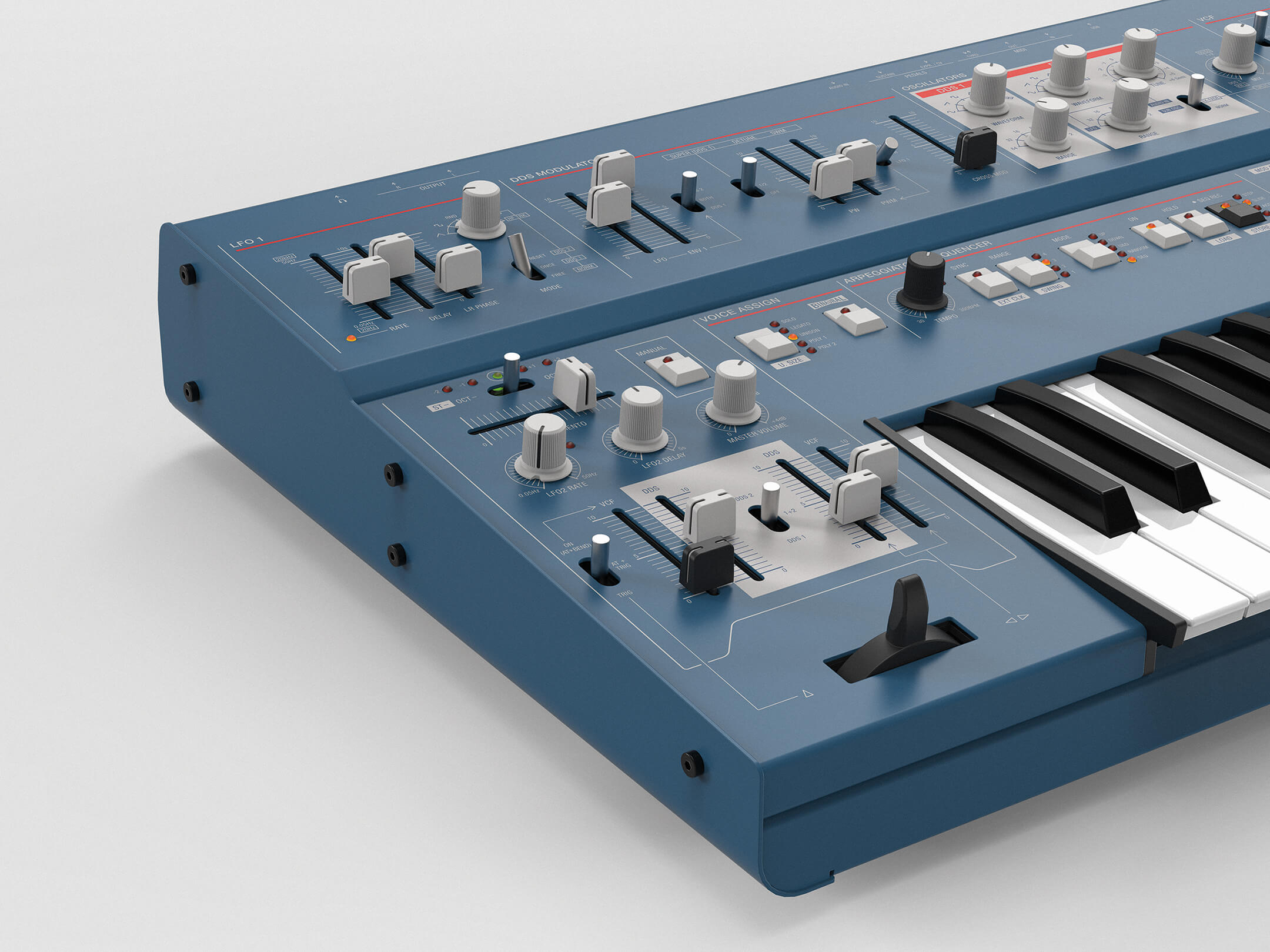
The Super 6 is certainly an investment. Its cost will put many potential users off but we have to reiterate its quality. This is a solidly built synthesiser that would look good alongside any other. It’s the kind of instrument that invites rabbit-hole playing whereby you’ll witter away hours playing and orchestrating unique sounds. For our money, you’d be hard pushed to find any hardware synths as good as this without spending much more.
The Super 6 has that contemporary edge that ensures it’s production-ready, yet is capable of vintage sounds too. Its styling is also top-notch. Available in both blue and grey, it’s reminiscent of all the synths we’ve loved before, only it offers far more in almost every degree. There are plenty of cool tricks to keep musicians and producers happy here.
Key features
- 12-voice polyphonic analogue-hybrid synthesiser
- FPGA oscillator voice architecture
- Binaural analogue signal path for stereo and spatial effects
- 128 onboard rewritable patch locations, with further patch saving via USB
- Built-in arpeggiator and step sequencer
- 49-note (four-octave) Fatar keyboard
- Multi-purpose LFOs and envelopes, with modulation matrix
- External audio input, with threshold-based envelope and LFO triggering
Alternatives
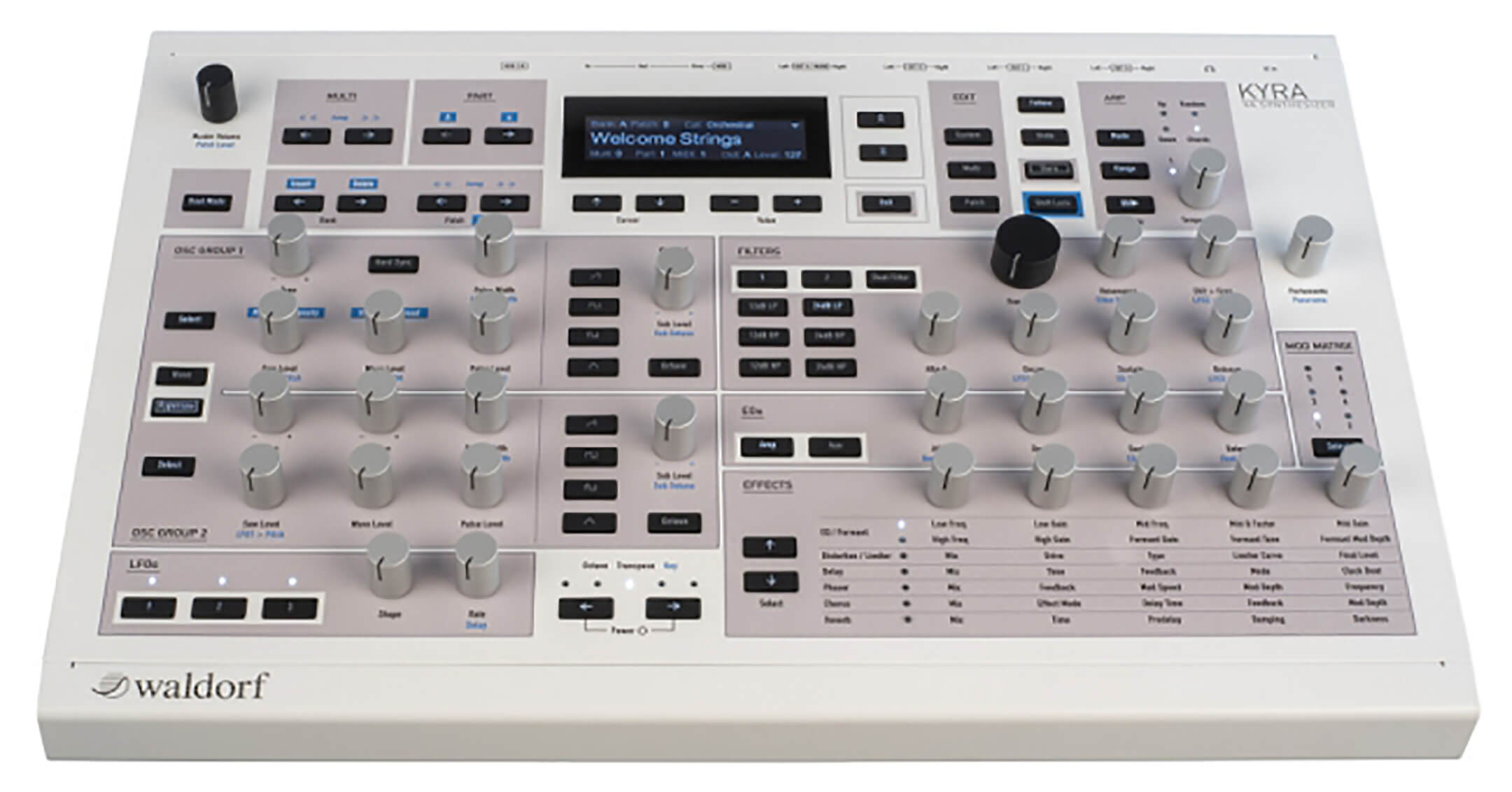
This digital synth lacks a keyboard but it’s another of the new breed of FPGA instruments that adopts the styling of a virtual analogue machine. It offers multi-timbral operation, alongside a 128 voice count.
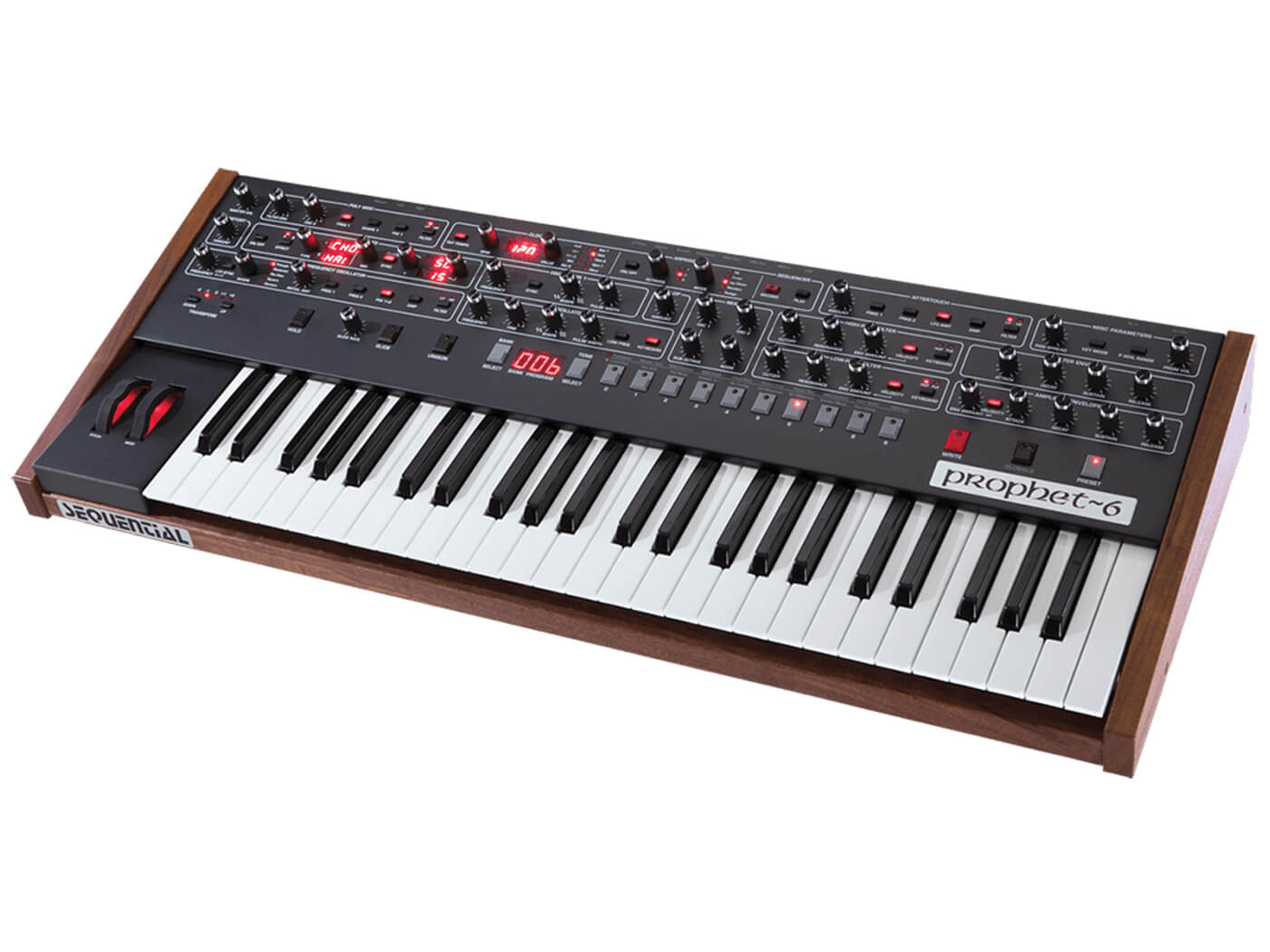
Sequential
Prophet 6 £2,400
The contemporary contender to the vintage crown, the Prophet 6 features two VCOs upfront and a 4-pole filter that draws inspiration from the original Prophet. It has the perfect balance of punch and warmth.
